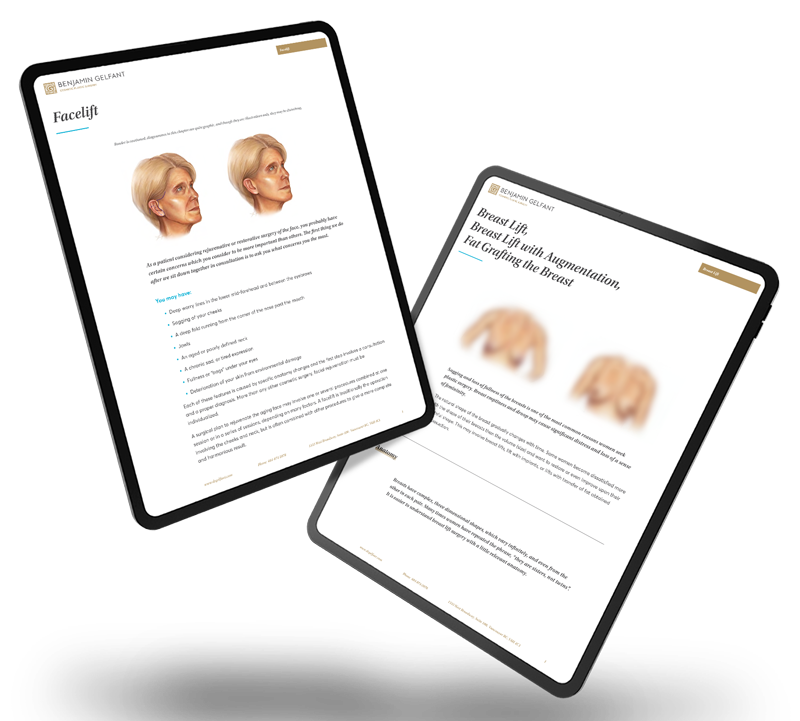A facelift (technically known as a rhytidectomy) is a procedure performed on the mid-to-low face that removes excess skin and tissues, tightens underlying facial muscles, and repositions facial fat.
When you look in the mirror do you see someone who looks older than you feel?
We all heard it when we were younger, “Age is a state of mind”.
It’s true. There are people who are younger than you who don’t have your vibrance and energy. But if your appearance belies that, maybe there’s something we can do for you.
To learn more about the different options available for face lifts, please review Dr. Gelfant’s short guide to FaceLift Surgery, which covers many common questions about:
- The aging process
- Incisions and scars
- Face lifts and neck lifts
- Risks involved
- Post operation care

Introduction to Facelift
Contemporary facelifts are restorations of facial form that rely on detailed knowledge of anatomy and precise surgery technique. You can expect to look like yourself, only better.
Facelift surgery involves:
- General (total) anaesthesia or local with sedation (“twilight”)
- Incisions designed for minimal hairline distortion, removal of excess skin and access to deeper structures
- Incision and Lifting skin away from deeper layers (developing the “flap”)
- Tightening of deep layers for support
- Modifying fat pockets as needed, adding and sometimes removing fat
- Removal of skin excess and repair of incisions
Looking For More Procedure Information?
Submit your email and receive Dr. Gelfant's illustrated patient guides in your inbox.

FAQs
What Is The Best Choice (Mid-Face Or Sub-Periosteal)?
This is something that cannot be decided upon without a proper discussion of your concerns and the possible treatment options and the alternatives. I sit with you and first listen carefully to your concern while we look at you in a mirror. I explain what I see is causing these changes (the diagnosis) and then plan the treatment. Your budget may also play a role, but it is best not to consider this until after we have a full understanding of the problem and the best treatments.
How Long Will A Facelift Last?
We are often asked how long the benefits from surgery will last. A well-done facelift with eyelids and forehead, either at one session or spaced in intervals, will often be the only one done for many years, often the only such surgery in a person’s life. Surgery does not make the face freeze at an age, nor are there sudden losses of the effect such that it suddenly becomes time to do it again.
The common way we describe the longevity of the surgery is that it sets the clock of aging back; the clock continues to run thereafter.
The following 50-year-old patient returned to our clinic for a visit nearly six years after her facelift, endobrow lift, upper and lower eyelid-plasty and lip augmentation. She was certain she needed nothing further done for her face.
Will My Scars Be Noticeable?
My incision approach is based on what will give the most natural result and minimize scarring.
While inconspicuous incisions are very important to the success of the operation, the length of the incision plays little role in whether they are ultimately as invisible as possible.
Important influences on scarring are:
- Scar location
- Tension on skin
- Hair pattern and re-growth
- How you heal as an individual
- Gentleness of handling during surgery
How Does The Facelift Recovery Process Work?
I keep my facelift patients overnight. A facelift is an intimidating operation for a non-medical person to care for, and it is my impression patients and their caregiver have a much easier time if they are given information slowly in the first night and morning so they are ready when they go home.
Spending a night in the clinic is never seen as a waste. You are in expert hands with professional experienced nurses and this enhances the recovery The nurses give post-op teaching and I see my patient the morning after surgery.
Most patients are back to work in two weeks. By then there is usually little or no bruising. Often returning to work is even faster. We begin exercise with walking early and progress rapidly during the time from two to six weeks.
Scars heal (mature) according to a schedule individual to each person, but generally look their worst between 4 and 6 weeks after surgery, stabilize, and then begin to soften and fade, a process that takes from six to eighteen months.
How Much Does A Facelift Cost In Vancouver?
The price of a facelift surgery procedure varies based on the surgical technique used and whether it is performed along with other cosmetic surgery procedures.
It is best to discuss your options with a private consultation at our Vancouver clinic. You will be provided with a personalized quote as a part of the patient consultation process and we also provide you with different financing options.
How Does A Facelift Affect Skin Quality?
Environmental damage – sun, wind and cold, smoking – all ravage the skin. Exposure to these factors will cause fine lines criss-crossing the areas damaged, thinning of the skin, loose, inelastic skin, “age spots” and other features, even when the damage was early in life.
A facelift does not directly address any of these issues although it may make them less apparent because the underlying architecture is so improved. But if you have these concerns, you should discuss possible treatments with your surgeon who may refer you for dermatological care. Laser resurfacing and other such treatments are often the recommended treatments.
Additional Info.
Since 1996, we have been doing the forehead lift via very small incisions using the endoscope, the surgical telescope-like device that has successfully reduced knee surgery scars from long unsightly incisions to much smaller puncture sites. In the forehead lift this offers the advantage of reducing the incision from one which runs from ear to ear across the top of the head, to several very short incisions. The aims of this operation are threefold: to reduce the sagging of the brow, (thus it is often also known as a browlift); to reduce the action of the frown muscles at the top of the nose and between the eyes; and to reduce the frown lines running horizontally across the forehead, if these are significant.
The small incisions used are easily concealed in the scalp, and recovery is quite rapid, usually about one week before returning to regular activity.
At our Vancouver clinic, approximately 75% of patients undergoing a facelift also have a forehead lift either simultaneously or shortly thereafter, and since I started using the endoscope, forehead lifts alone or with some eyelid surgery have become much more common, and are often done in younger patients. Sometimes we also extend the forehead lift under the surface into the upper cheeks, and combined with eyelid surgery we are able to get some significant upper cheek lifting without additional incisions.
If you have any questions about a facelift procedure, our experienced and supportive staff is always available. Please call us at (604) 874-2078 or you can book your consultation today.